Relay Protection Setting Calculation System for Nuclear Power Plant Based on B/S Architecture and Cloud Computing
Abstract
1. Introduction
2. Architecture and Ideas
3. Cloud Computing Key Technologies
3.1. Cloud Computing Task Distribution Synchronization Mechanism
3.2. Automatic Assembly Mechanism of Cloud Components
3.3. Operation Mechanism of Cloud Computing System
4. Setting Calculation Case of Nuclear Power Plant
4.1. Relay Protection Setting Calculation Function of Nuclear Power Plant
4.2. Calculation Efficiency of Relay Protection Setting in Nuclear Power Plants
5. Conclusions
Author Contributions
Funding
Acknowledgments
Conflicts of Interest
References
- Wang, Y.Z.; Zhou, S. Comprehensive assessment of the environmental impact of China’s nuclear and other power generation technologies. J. Tsinghua Univ. Sci. Technol. 2021, 61, 377–384. [Google Scholar]
- Wu, H.S.; Wang, H.D. Present situation of world nuclear power. News Oversea Nucl. 2011, 1, 7–10. (In Chinese) [Google Scholar]
- Ye, Q.Z. China’s nuclear power development after Fukushima nuclear power plant accident. In Proceedings of the IEEE Conference on Software Engineering Education and Training, Nanjing, China, 17–19 April 2012; Volume 32, pp. 1–8. (In Chinese). [Google Scholar]
- Wu, P.; Yang, Y.C. Research on Operational Characteristics and Core Simulation of the Third-Generation Nuclear Reactor AP1000. Power Syst. Technol. 2014, 38, 1196–1202. [Google Scholar]
- Maldonado, G.I. The performance of North American nuclear power plants during the electric power blackout of August 14, 2003, In IEEE Symposium Conference Record Nuclear Science 2004, Proceedings of the IEEE Symposium on Nuclear Science (NSS/MIC), Rome, Italy, 16–22 October 2004; IEEE: Piscataway, NJ, USA, 2004. [Google Scholar]
- Ma, J.P.; Jiang, J. Applications of fault detection and diagnosis methods in nuclear power plants: A review. Nucl. Energy 2011, 53, 255–266. [Google Scholar] [CrossRef]
- Eom, H.-S.; Park, G.-Y. V&V-based remaining fault estimation model for safety–critical software of a nuclear power plant. Nucl. Energy 2013, 51, 38–49. [Google Scholar]
- Yang, F.; Zhao, D.M. Research of relay protection setting calculation system for power plant based on Multi-agent. In Proceedings of the 2010 Asia-Pacific Power and Energy Engineering Conference, Chengdu, China, 28–31 March 2010. [Google Scholar]
- Andreev, M.; Gusev, A. Setting of relay protection of electric power systems using its mathematical models. In Proceedings of the 2017 IEEE PES Innovative Smart Grid Technologies Conference Europe (ISGT-Europe), Turin, Italy, 26–29 September 2017. [Google Scholar]
- Roman, V.; Klyuev, I.; Bosikov, I. Improving the efficiency of relay protection at a mining and processing plant. J. Min. Inst. 2021, 248, 300–311. [Google Scholar]
- Chang, C.-K.; Elmashtoly, A.M. Protection Coordination Index Assessment Using Fuzzy Logic Controller. Energies 2022, 15, 1377. [Google Scholar] [CrossRef]
- Lu, Y.; Chung, J.-L. Detecting and solving the coordination curve intersection problem of overcurrent relays in subtransmission systems with a new method. Electr. Power Syst. Res. 2013, 95, 19–27. [Google Scholar] [CrossRef]
- Bouchekara, H.; Zellagui, M.; Abido, M.; Bouchekara, H.R.E.-H. Optimal coordination of directional overcurrent relays using a modified electromagnetic field optimization algorithm. Appl. Soft Comput. 2017, 54, 267–283. [Google Scholar] [CrossRef]
- Zeineldin, H.H.; Sharaf, H.M.; Ibrahim, D.K.; El-Zahab, E.E.D.A. Optimal Protection Coordination for Meshed Distribution Systems with DG Using Dual Setting Directional Over-Current Relays. IEEE Trans. Smart Grid 2015, 6, 115–123. [Google Scholar] [CrossRef]
- Prenc, R.; Rojnić, M. On the Development of Overcurrent Relay Optimization Problem for Active Distribution Networks. Energies 2022, 15, 6528. [Google Scholar] [CrossRef]
- Li, D. Relay Coordination and Setting Management Integrated System Based on Hybrid Architecture. Master’s Thesis, Huazhong University of Science and Technology, Wuhan, China, April 2006. [Google Scholar]
- Jie, Z. Protection Coordination Software for Distribution Networks Based on C/S. Master’s Thesis, Huazhong University of Science and Technology, Wuhan, China, May 2003. [Google Scholar]
- Liu, Q.; Chen, S. Object-Oriented methods drive protective relay system. IEEE Comput. Appl. Power 2000, 14, 33–37. [Google Scholar]
- Zhang, J.P.; Zhu, X.D.; Liang, X. C/S and B/S Mixed Style and the Application. In Proceedings of the 2009 First International Workshop on Education Technology and Computer Science, Wuhan, China, 7–8 March 2009. [Google Scholar]
- Yang, A.; Wu, J.; Wang, L. Research and Design of Test Question Database Management System Based on the Three-Tier Structure. WSEAS Trans. Syst. 2008, 7, 1473–1483. [Google Scholar]
- Wang, L. Research of Geological Exploration Information System Based on Three-tiered C/S Architecture. Adv. Mater. Res. 2012, 490–495, 2942–2945. [Google Scholar] [CrossRef]
- Wan, C.T.; Ling, W.W. Three-tier Multi-Agent Architecture for Asset Management Consultant. In Proceedings of the 2004 IEEE International Conference on e-Technology, e-Commerce and e-Service, Taipei, Taiwan, 28–31 March 2004. [Google Scholar]
- Nuclear Power Engineering Committee of the IEEE Power Engineering Society. IEEE Standard Criteria for Digital Computers in Safety Systems of Nuclear Power Generating Stations; IEEE: Piscataway, NJ, USA, 1993. [Google Scholar]
- Hu, S.; Xiao, Y. Design of cloud computing task offloading algorithm based ondynamic multi-objective evolution. Future Gener. Comput. Syst. 2021, 122, 144–148. [Google Scholar] [CrossRef]
- Alla, H.B.; Alla, S.B.; Touhafi, A.; Ezzati, A. A novel task scheduling approach based on dynamic queues and hybrid meta-heuristic algorithms for cloud computing environment. Clust. Comput. 2018, 21, 1797–1820. [Google Scholar] [CrossRef]
- Sreenu, K.; Malempati, S. MFGMTS: Epsilon constraint-based modified fractional grey wolf optimizer for multi-objective task scheduling in cloud computing. IETE J. Res. 2019, 65, 201–215. [Google Scholar] [CrossRef]
- Aziza, H.; Krichen, S. Bi-objective decision support system for taskscheduling based on genetic algorithm in cloud computing. Computing 2018, 100, 65–91. [Google Scholar] [CrossRef]
- Agarwal, A.; Jain, S. Efficient optimal algorithm of task-scheduling in cloud computing environment. Int. J. Comput. Trends Technol. 2014, 9, 344–349. [Google Scholar] [CrossRef]
- Sim, K.M.; Sun, W.H. Ant Colony Optimization for Routing and Load-Balancing Survey and New Directions. Syst. Man Cybern. Part A Syst. Hum. 2003, 33, 560–572. [Google Scholar]
- Simone, A.; Ludwig, A.M. Swarm Intelligence Approaches for Grid Load Balancing. Grid Comput. 2011, 9, 279–301. [Google Scholar]
- Chow, K.P.; Rwok, Y.K. On load balancing for distributed multi-agent computing. IEEE Trans. Parallel Distrib. Syst. 2002, 13, 787–801. [Google Scholar] [CrossRef]
- Mapetu, J.P.B.; Chen, Z.; Kong, L.F. Low-time complexity and low-cost binary particle swarm optimization algorithm for task scheduling and load balancing in cloud computing. Appl. Intell. 2019, 43, 3308–3330. [Google Scholar] [CrossRef]
- Ramezani, F.; Jie, L.; Hussain, K.F. Task-based system load balancing in cloud computing using particle swarm optimization. Int. J. Parallel Prog. 2014, 42, 739–754. [Google Scholar] [CrossRef]
- Pandey, S.; Wu, L.; Guru, S.M.; Buyya, R. A Particle swarm optimization-based heuristic for scheduling workflow applications in cloud computing environments. In Proceedings of the 24th IEEE International Conference on Advanced Information Networking and Applications, Perth, Australia, 20–23 April 2010; pp. 400–407. [Google Scholar] [CrossRef]
- Valarmathi, R.; Sheela, T. A comprehensive survey on task scheduling for parallel workloads based on particle swarm optimization under cloud environment. In Proceedings of the 2nd International Conference on Computing and Communications Technologies (ICCCT), Chennai, India, 23–24 February 2017; pp. 81–86. [Google Scholar] [CrossRef]
- Boetinser, D.W.; Wemer, D.H. Particle swarm Optimization Versus Cenetic Algonithms for Phased Artay synthesis. Antennas Propag. 2004, 52, 711–779. [Google Scholar]
- Wadood, A.; Kim, C.-H. Application of a Continuous Particle Swarm Optimization (CPSO) for the Optimal Coordination of Overcurrent Relays Considering a Penalty Method. Energies 2018, 11, 869. [Google Scholar] [CrossRef]
- Zeineldin, H.H.; El-Saadany, E.F.; Salama, M.M.A. Optimal coordination of overcurrent relays using a modified particle swarm optimization. Electr. Power Syst. Res. 2006, 76, 988–995. [Google Scholar] [CrossRef]
- Antonio, J.; Medeiros, C.C.; Schirru, R. Identification of nuclear power plant transients using the particle swarm optimization algorithm. Ann. Nucl. Energy 2008, 35, 576–582. [Google Scholar]
- Mansour, M.M.; Mekhamer, S.F.; El-Kharbawe, N. A modified particle swarm optimizer for the coordination of directional overcurrent relays. IEEE Trans. Power Deliv. 2007, 22, 1400–1410. [Google Scholar] [CrossRef]
- Park, J.B.; Lee, K.S.; Shin, J.R.; Lee, K.Y. A particle swarm optimization for economic dispatch with nonsmooth cost functions. IEEE Trans. Power Syst. 2005, 20, 34–42. [Google Scholar] [CrossRef]
- Liu, G.P. Research on on-line Setting and Assessment Early Warning of Relay Protection in Regional Grid. Doctoral Dissertation, North China Electric Power University, Beijing, China, June 2013. [Google Scholar]
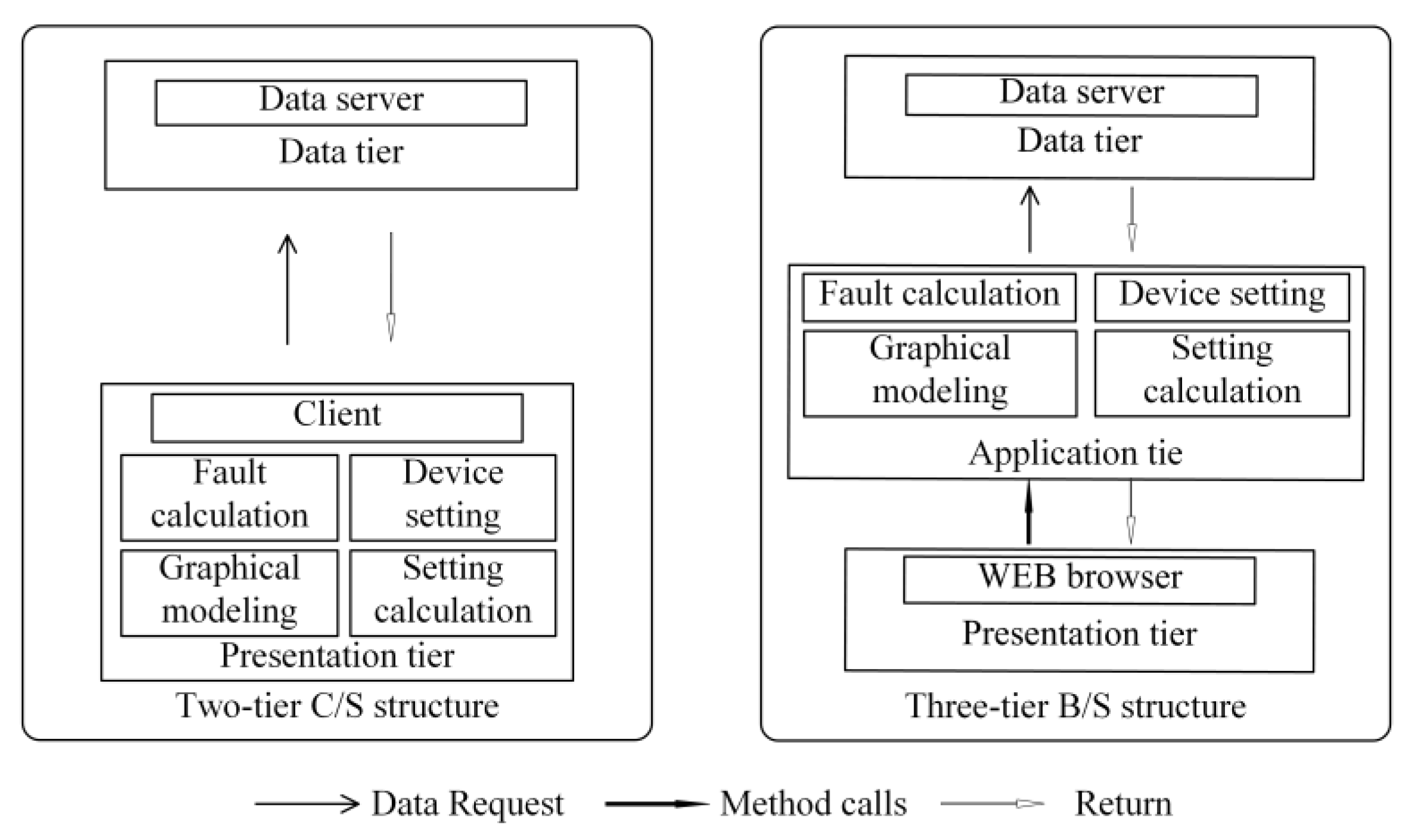
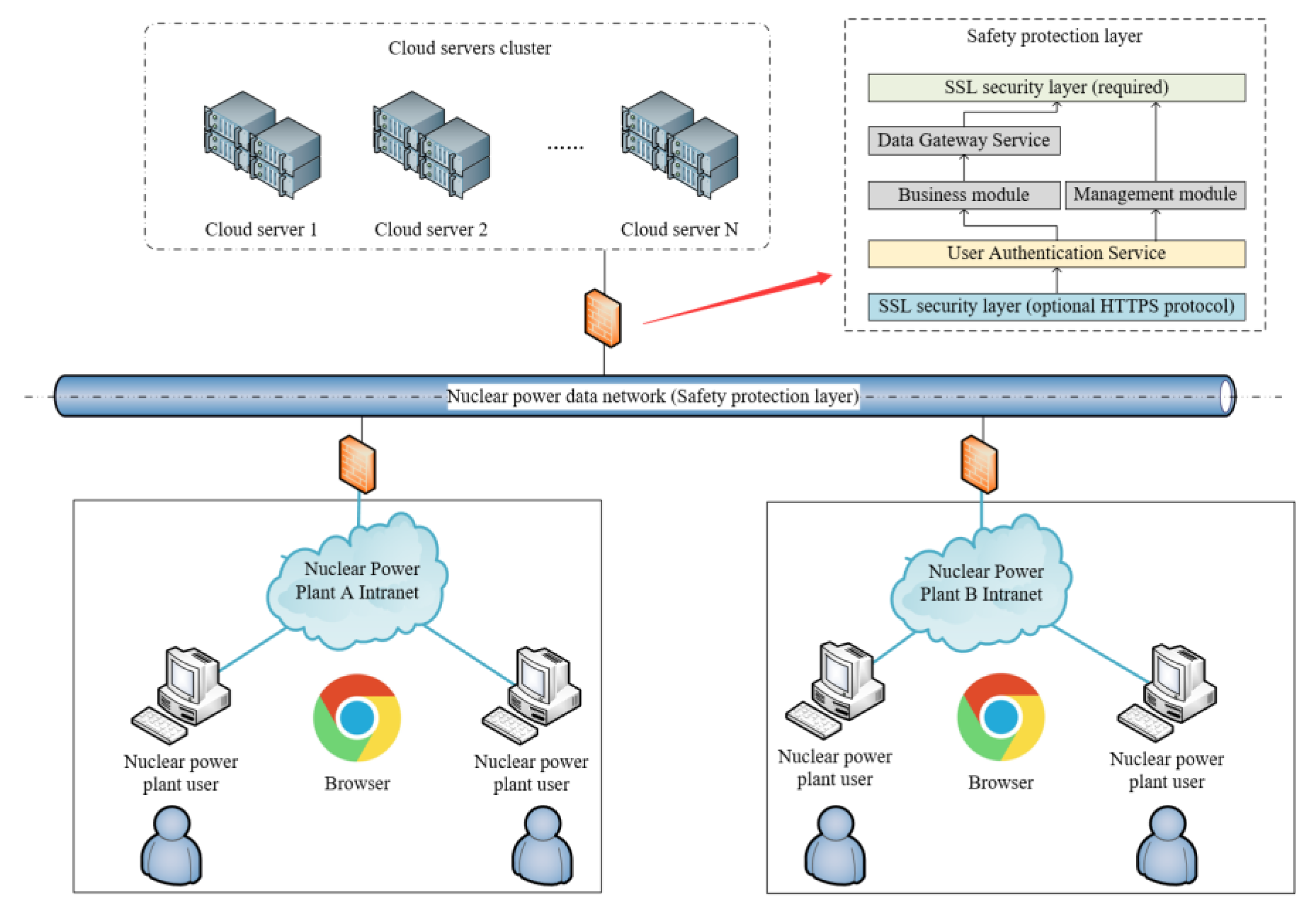
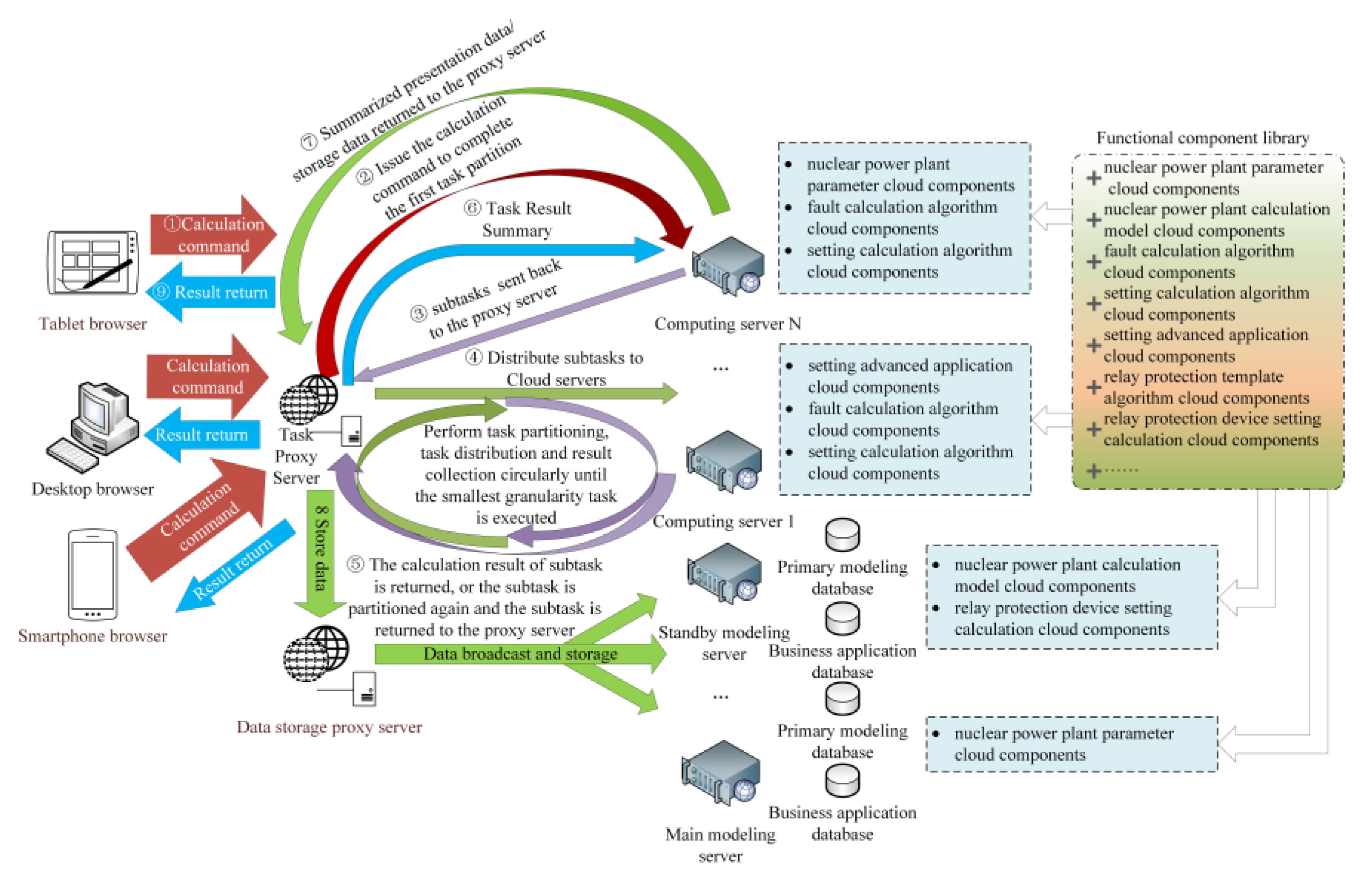
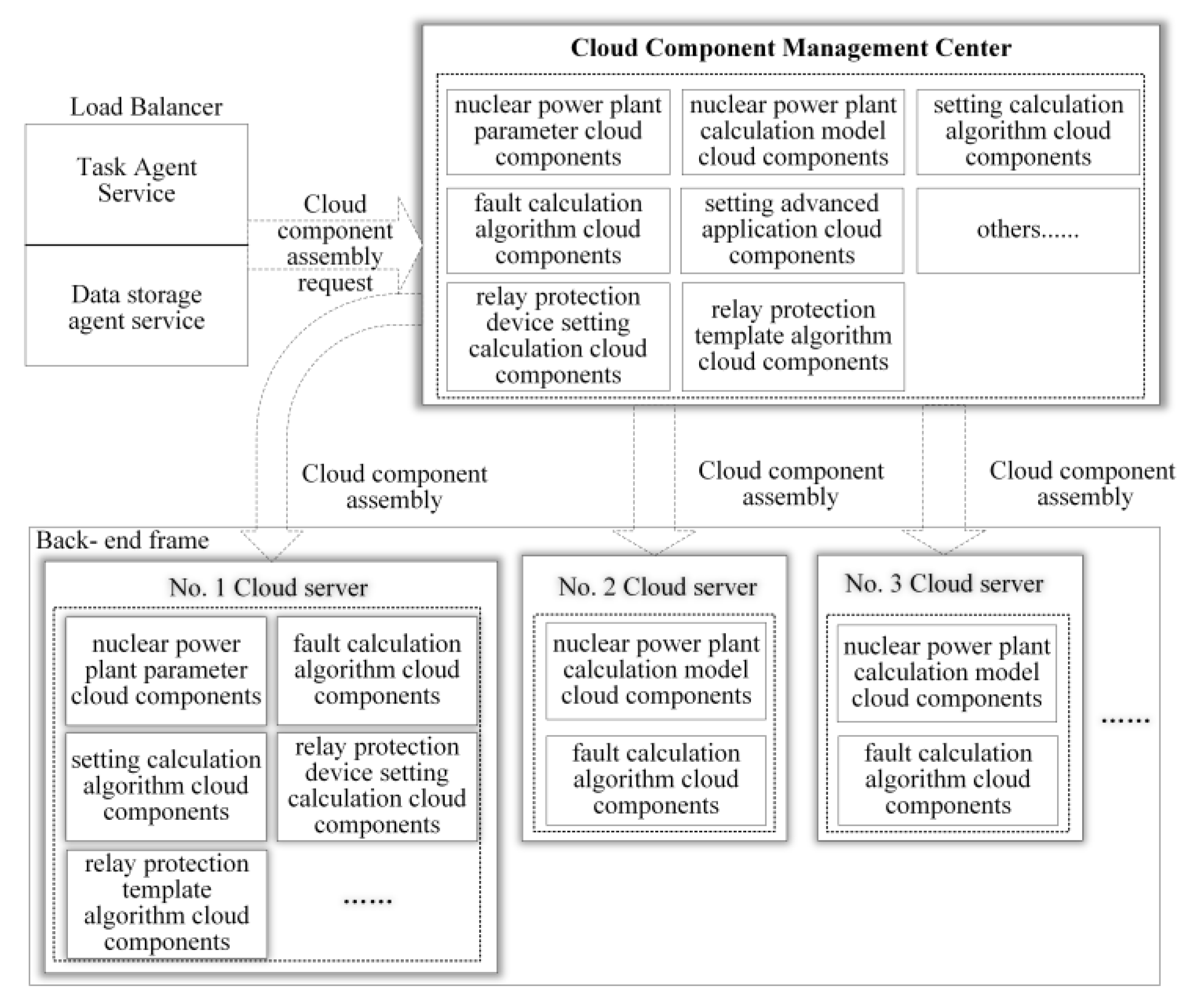
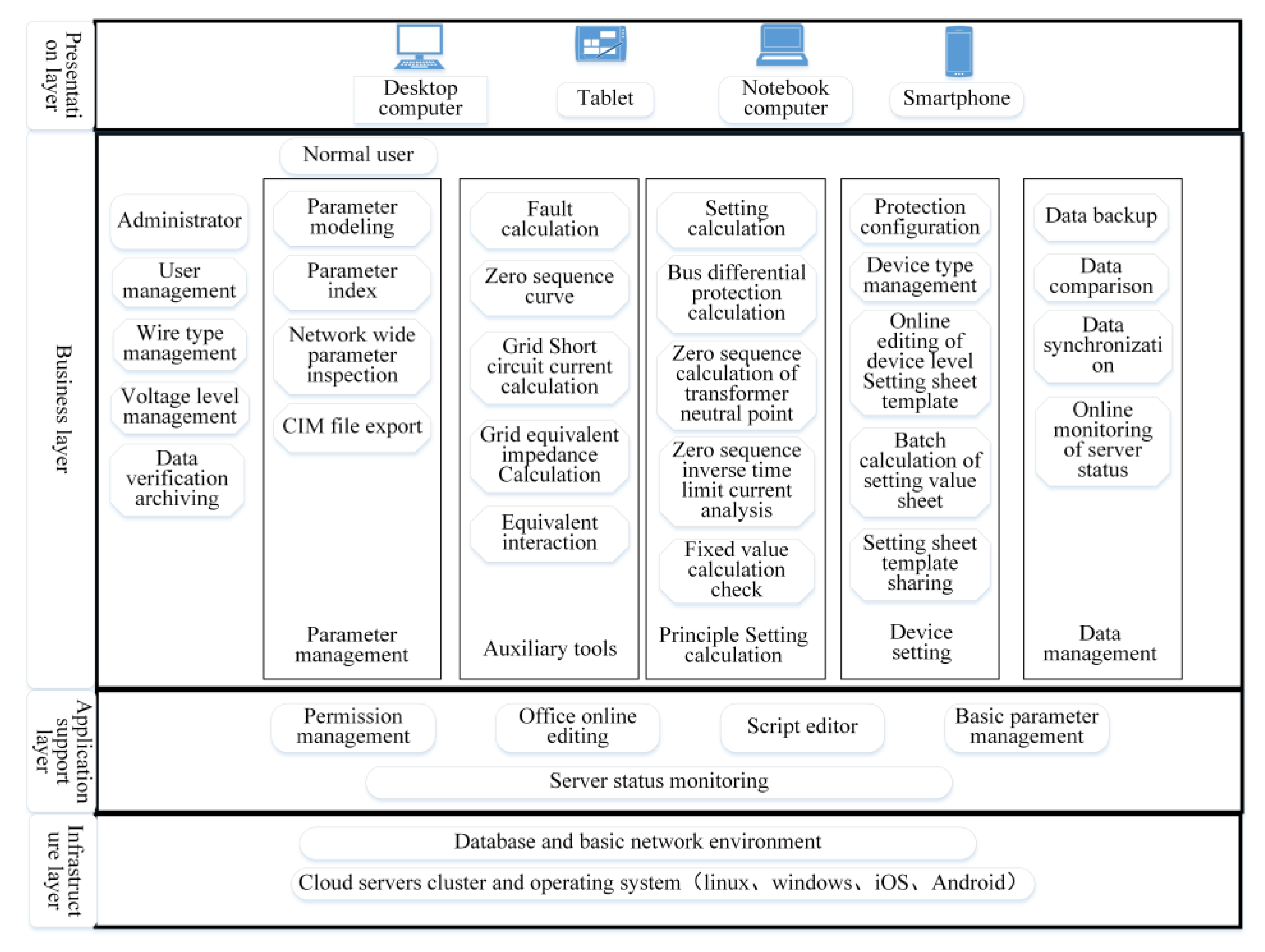
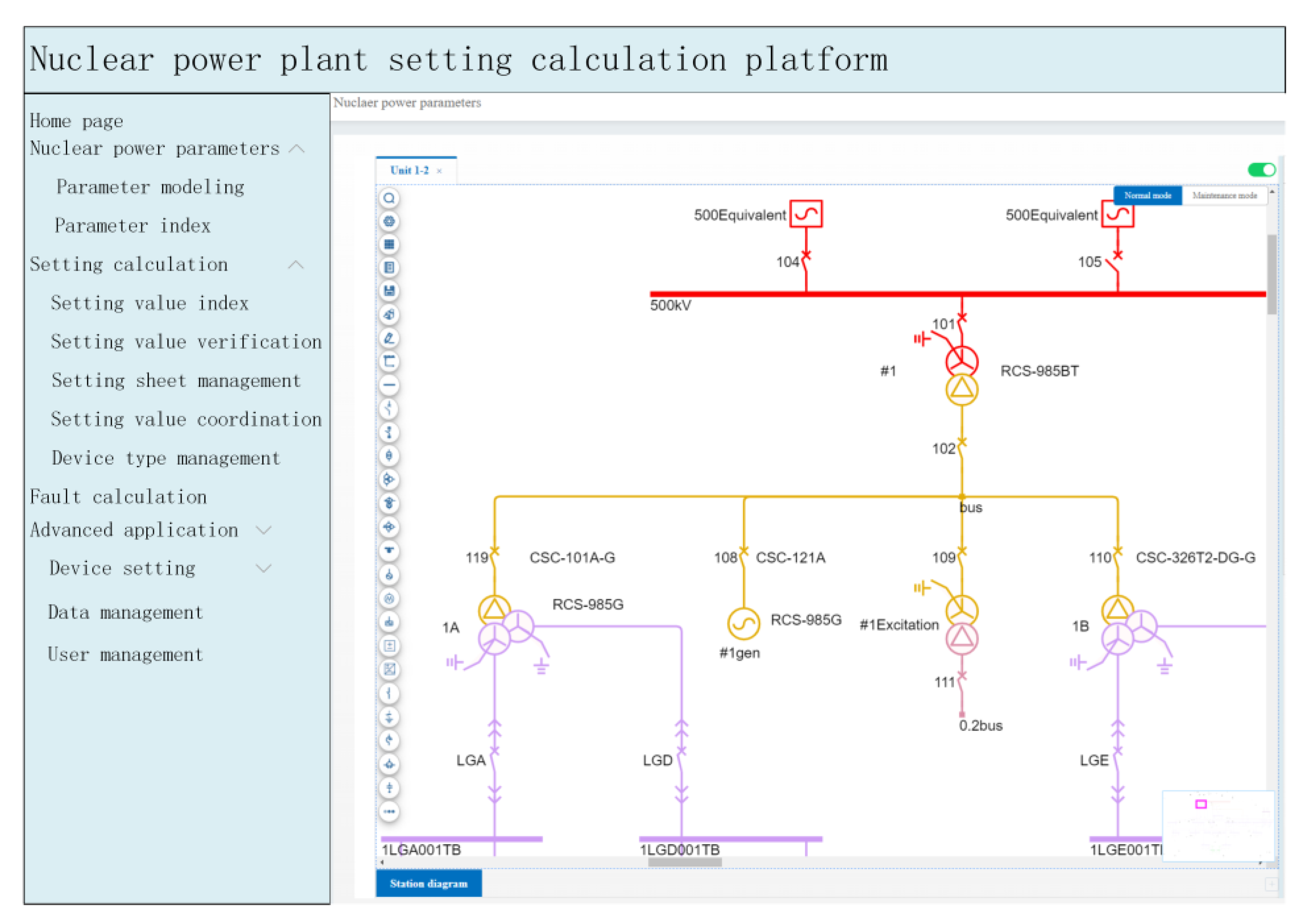
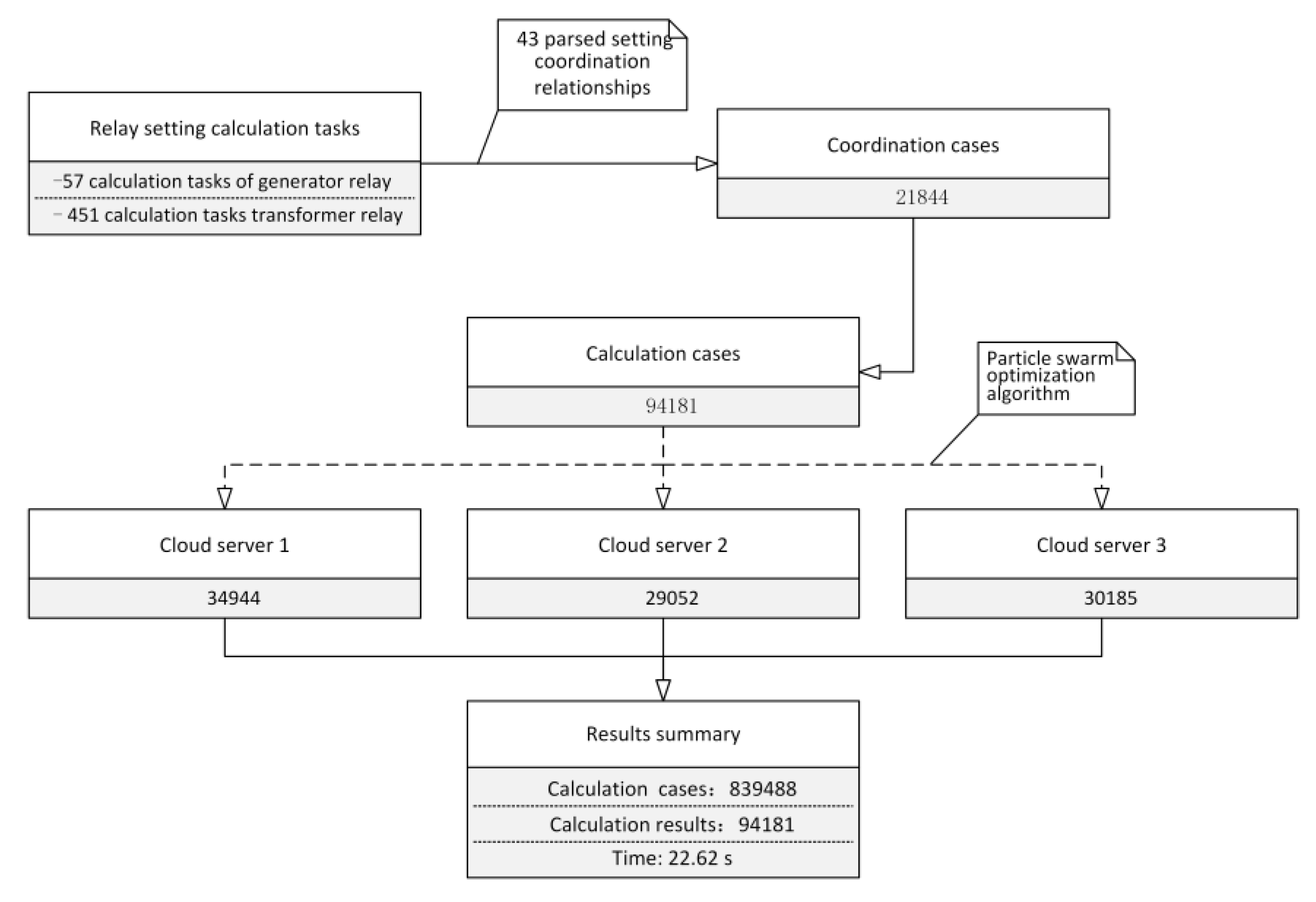
| Processes Number | Calculation Time/s | Acceleration Ratio |
|---|---|---|
| 1 | 1089.15 | 1.00 |
| 2 | 553.43 | 1.97 |
| 5 | 220.48 | 4.94 |
| 10 | 110.49 | 9.86 |
| 15 | 74.78 | 14.56 |
| 20 | 56.76 | 19.19 |
| 25 | 48.14 | 22.62 |
| 30 | 41.09 | 26.51 |
| 40 | 30.81 | 35.35 |
| 50 | 22.62 | 42.98 |
Publisher’s Note: MDPI stays neutral with regard to jurisdictional claims in published maps and institutional affiliations. |
© 2022 by the authors. Licensee MDPI, Basel, Switzerland. This article is an open access article distributed under the terms and conditions of the Creative Commons Attribution (CC BY) license (https://creativecommons.org/licenses/by/4.0/).
Share and Cite
Hong, Y.; Yu, Y.; Tian, J.; Ye, H.; Wang, B.; Yu, W. Relay Protection Setting Calculation System for Nuclear Power Plant Based on B/S Architecture and Cloud Computing. Energies 2022, 15, 9648. https://doi.org/10.3390/en15249648
Hong Y, Yu Y, Tian J, Ye H, Wang B, Yu W. Relay Protection Setting Calculation System for Nuclear Power Plant Based on B/S Architecture and Cloud Computing. Energies. 2022; 15(24):9648. https://doi.org/10.3390/en15249648
Chicago/Turabian StyleHong, Yuan, You Yu, Jingfu Tian, Han Ye, Bin Wang, and Wenxiang Yu. 2022. "Relay Protection Setting Calculation System for Nuclear Power Plant Based on B/S Architecture and Cloud Computing" Energies 15, no. 24: 9648. https://doi.org/10.3390/en15249648
APA StyleHong, Y., Yu, Y., Tian, J., Ye, H., Wang, B., & Yu, W. (2022). Relay Protection Setting Calculation System for Nuclear Power Plant Based on B/S Architecture and Cloud Computing. Energies, 15(24), 9648. https://doi.org/10.3390/en15249648








